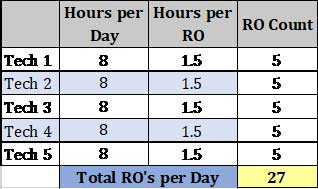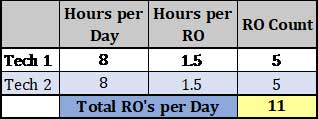A question we are often asked is how many repair orders a Service Advisor should write per day. Before we answer, let’s clarify the question. Are we looking for an average compared to other stores? Or are we asking how many repair orders our Service Advisors can write up per day while maintaining a high level of guest satisfaction, shop production, and profitability? This article is not about giving you a number; it’s about exploring areas that affect repair order count. With so many areas, we could probably write a book, but here are just three:
- Does your store have a written lane process?
- Are the Service Advisors trained on this process?
- Are the Service Advisors consistently graded on their execution of the process?
- Do we identify areas of improvement?
- Do we coach the Advisors on these areas?
Most retailers will have a written lane process. Seldom do we see the Service Advisors get formal classroom or on-the-lane training on how to perform the process. New Service Advisor training is usually focused on the computer. The goal of this training is to get the new Advisor comfortable enough to write, dispatch, and book a repair order. This is where the training usually ends. But, what about the written lane process? The Advisor usually gets a copy on their first day. Could we do more?
We routinely see Salespeople attending in-store or online training. Do we consistently have Service Advisor training? Service Advisors interact with more guests than any other position in the dealership. You would think consistently training them would be our highest priority. Do you think an Advisor who is trained on our lane process could write more RO’s than one who’s not trained?
In the rare case where we see the Advisor trained on the written process, seldom do we see the Advisors graded on it. Ever heard the saying “inspect what you expect”? The grading process is the “inspect” part of that saying. Don’t overcomplicate the grading. Make it simple and objective. An example would be: did the Advisor greet the guest at the vehicle? Yes or No? When we start getting too complicated, for example, how friendly was the Advisor’s greeting? It becomes difficult to grade their performance. Our primary objective is to get the Advisors to follow the process. Once they follow the process, we can improve the execution of the process. When we identify areas of improvement and coach the Advisors, it helps them improve. When they improve, we improve. Do you think an Advisor who is graded on our lane process could write more RO’s than one that’s not graded?
- What are Service Advisors’ job responsibilities?
- Do we have a cashier, or are the Service Advisors cashiering?
- Do we have appointment coordinators, or are the Service Advisors answering phones and making appointments?
- Who’s dispatching work? Is it the Service Advisors?
Over the years, the job responsibilities of a Service Advisor have evolved. Often, we have the Advisors taking payment, making appointments, and dispatching. But, consider how much time Advisors spend on these jobs. I’m not saying an Advisor should not cash in, but the amount of repair orders an Advisor writes could be affected by whether they cashier or not.
- What is the Technician-to-Service Advisor ratio in the shop?
- Does the Advisor have dedicated Technicians?
- How many Technicians does the Advisor have?
Technician-to-Advisor ratios are an important factor when it comes to repair order count. The chart below shows a few scenarios. We used 1.5 hours per RO and 8 flat rate hours per Technician as the average. Notice as the Technician count changes so does the RO count.
Scenario 1 (5 Technicians to 1 Advisor): In this case, the Advisor would average 27 RO’s per day.

Scenario 2 (3 Technicians to 1 Advisor): In this case, the Advisor would average 16 RO’s per day.

Scenario 3 (2 Technicians to 1 Advisor): In this case, the Advisor would average 11 RO’s per day.

Now I ask you, how many RO’s per day should an Advisor write?
We are asked questions all the time about benchmarks. Let us take a look at your business and help find areas of improvement. This is just a small example of the hidden detail we can uncover in your store. This information will allow us to create a strategy to increase your profits. Our goal is to help you have loyal customers, and happy employees, and make some money too.